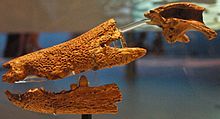Peirosauridae
| Peirosauridae Temporal range:
| |
|---|---|

| |
| Skull of the peirosaurid Hamadasuchus rebouli on display at the Royal Ontario Museum | |
| Scientific classification | |
| Domain: | Eukaryota |
| Kingdom: | Animalia |
| Phylum: | Chordata |
| Class: | Reptilia |
| Clade: | Archosauria |
| Clade: | Pseudosuchia |
| Clade: | Crocodylomorpha |
| Clade: | Crocodyliformes |
| Clade: | †Notosuchia |
| Clade: | †Sebecosuchia |
| Clade: | †Sebecia |
| Family: | †Peirosauridae Gasparini, 1982 |
Peirosauridae is a Gondwanan family of mesoeucrocodylians that lived during the Cretaceous period. It was a clade of terrestrial crocodyliforms that evolved a rather dog-like form, and were terrestrial carnivores. It was phylogenetically defined in 2004 as the most recent common ancestor of Peirosaurus and Lomasuchinae and all of its descendants. Lomasuchinae is a subfamily of peirosaurids that includes the genus Lomasuchus.[1]
Lomasuchinae was defined in the same 2004 study as the most recent common ancestor of Lomasuchus and Mahajangasuchini and all of its descendants. Mahajangasuchini, also constructed in the study, was defined as the most recent common ancestor of Mahajangasuchus and Uberabasuchus and all of its descendants.[1] However, all more recent phylogenetic analyses placed Mahajangasuchus within its own family, Mahajangasuchidae, along with the newly named Kaprosuchus.[2][3][4]
Genera
The following list of genera follows Martinelli et al., 2012 unless otherwise noted.[5]
- Barcinosuchus from the Aptian - Albian of Argentina.
- Bayomesasuchus from the Turonian - Cenomanian of Argentina.[6]
- Gasparinisuchus from the Santonian - early Campanian of Argentina.
- Hamadasuchus from the Albian - Cenomanian of Morocco.
- Lomasuchus from the Santonian of Argentina.
- Montealtosuchus from the Turonian - Santonian of Brazil.
- Peirosaurus from the late Maastrichtian of Brazil.
- Pepesuchus from the Campanian - Maastrichtian of Brazil.
- Uberabasuchus from the late Maastrichtian of Brazil.
References
- ^ a b Carvalho, I.S.; Ribeiro, L.C.B.; Avilla, L.S. (2004). "Uberabasuchus terrificus sp. nov., a new Crocodylomorpha from the Bauru Basin (Upper Cretaceous), Brazil" (PDF). Gondwana Research. 7 (4): 975–1002. doi:10.1016/S1342-937X(05)71079-0.
- ^ Sereno, P. C.; Larsson, H. C. E. (2009). "Cretaceous crocodyliforms from the Sahara". ZooKeys. 28 (2009): 1–143. doi:10.3897/zookeys.28.325.
{{cite journal}}: CS1 maint: unflagged free DOI (link) - ^ Turner, Alan H.; Sertich, Joseph J. W. (2010). "Phylogenetic history of Simosuchus clarki (Crocodyliformes: Notosuchia) from the Late Cretaceous of Madagascar". Journal of Vertebrate Paleontology. 30 (6, Memoir 10): 177–236. doi:10.1080/02724634.2010.532348.
- ^ Marco Brandalise de Andrade, Richard Edmonds, Michael J. Benton and Remmert Schouten (2011). "A new Berriasian species of Goniopholis (Mesoeucrocodylia, Neosuchia) from England, and a review of the genus". Zoological Journal of the Linnean Society. 163 (s1): S66–S108. doi:10.1111/j.1096-3642.2011.00709.x.
{{cite journal}}: CS1 maint: multiple names: authors list (link) - ^ Agustín G. Martinelli, Joseph J.W. Sertich, Alberto C. Garrido and Ángel M. Praderio (2012). "A new peirosaurid from the Upper Cretaceous of Argentina: Implications for specimens referred to Peirosaurus torminni Price (Crocodyliformes: Peirosauridae)". Cretaceous Research. in press. doi:10.1016/j.cretres.2012.03.017.
{{cite journal}}: CS1 maint: multiple names: authors list (link) - ^ Francisco Barrios, Ariana Paulina-Carabajal; Paula Bona (2015). "A new peirosaurid (Crocodyliformes, Mesoeucrocodylia) from the Upper Cretaceous of Patagonia, Argentina". Ameghiniana. in press. doi:10.5710/AMGH.03.09.2015.2903.
{{cite journal}}: Unknown parameter|lastauthoramp=ignored (|name-list-style=suggested) (help)
External links

